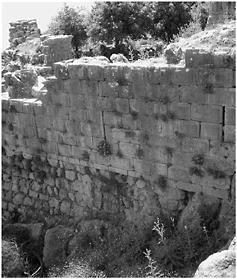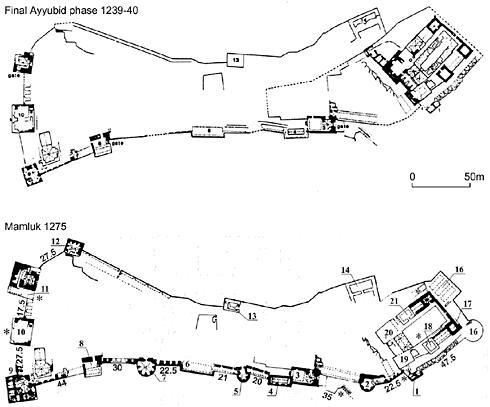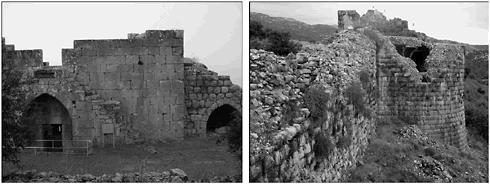Muslim Fortresses in the Levant: Between Crusaders and Mongols (84 page)
Read Muslim Fortresses in the Levant: Between Crusaders and Mongols Online
Authors: Kate Raphael
Tags: #Arts & Photography, #Architecture, #Buildings, #History, #Middle East, #Egypt, #Politics & Social Sciences, #Social Sciences, #Human Geography, #Building Types & Styles, #World, #Medieval, #Humanities

As for defensive importance, the role of the fortress was of greater significance for the protection of Damascus under the Ayyubids than for the defense of the Mamluk sultanate.
defensive importance, the role of the fortress was of greater significance for the protection of Damascus under the Ayyubids than for the defense of the Mamluk sultanate.
Ibn Shaddād presents a short report, and is rather sparing of words in describing the reconstruction carried out when the site passed into Bīlīk’s responsibility. He begins with a brief account in which he uses the verb “to renew” (
jaddada
) in referring to the fortress in general. When he goes into detail he switches to the verb “to build” . Ibn Shaddād’s account ends with the description of a minaret that was added to the already existing mosque, a residence built for the
. Ibn Shaddād’s account ends with the description of a minaret that was added to the already existing mosque, a residence built for the
nā’ib and a bridge that led to the fortress.
and a bridge that led to the fortress.
77
When Ibn Shaddād’s account is correlated with the archeological remains it appears to be quite accurate, in contrast to his report of the destruction carried out by the Mongols, which as noted above is somewhat exaggerated. Through the construction stretched over several years, it was completed during the reign of Baybars. No later buildings are recorded in the Mamluk sources.
The return of the round towers
The most dominant structures at , probably the trademark of Mamluk military architecture, are the round towers built along the southern Ayyubid curtain wall. While towers of this type are rarely seen in Ayyubid rural and frontier fortresses in southern Syria and Palestine, they were introduced on a lavish scale in the early Mamluk period and feature in almost every fortress the Mamluks rebuilt. They were known in late twelfth and early thirteenth century Crusader fortresses, although they are not very common.
, probably the trademark of Mamluk military architecture, are the round towers built along the southern Ayyubid curtain wall. While towers of this type are rarely seen in Ayyubid rural and frontier fortresses in southern Syria and Palestine, they were introduced on a lavish scale in the early Mamluk period and feature in almost every fortress the Mamluks rebuilt. They were known in late twelfth and early thirteenth century Crusader fortresses, although they are not very common.
78
The two main advantages of round towers are they are less prone to damage from siege machines, as the surface hit by projectiles is smaller,
79
and the defenders stationed in the tower have a wider angle of vision.
The other striking change manifested during this Mamluk building phase is the increase in the number of towers. A new round Mamluk tower was inserted between every two rectangular Ayyubid towers. This no doubt improved the bowmen’s efficacy and further reduced the dead ground below the walls. By the end of the Mamluk reconstruction phase the number of towers along the southern curtain wall was nine; as opposed to five in the final Ayyubid phase.
One of the most interesting features in this site is the fact that the Mamluks who demonstrated such high ability in the construction of towers were willing to make do with the poor structure of the Ayyubid curtain walls. The walls ere repaired, but their structure and width did not change (
Figure 4.3
). The Mamluks decided to counteract the weaknesses and faults of the curtain walls by almost doubling the number of towers. This approach had in fact been initiated by the Ayyubids, who, as was shown in the previous chapter, laid greater emphasis on the design and construction of their towers than on their curtain walls. The Mamluks improved and further developed this concept. Thus the dense line of towers provided the strongest part of the defense, while the curtain walls became an almost negligible factor. The flanking fire from the series of towers would have been extremely powerful if every archer took his position.

Figure 4.3 , Mamluk repairs along the Ayyubid walls
, Mamluk repairs along the Ayyubid walls
All four round towers share the same basic structure and features. The Mamluk towers were inserted into the Ayyubid curtain wall, four sections being broken to make space for them. Once completed, the new tower was carefully reconnected or “stitched” to the Ayyubid wall (Figures
4.4
,
4.5
).
The diameter of the round towers runs between 10 and 18m; their base is completely solid. The walls ere built in a similar fashion to the curtain walls. The stones are marginal drafted leaving a large projecting boss, which would enable the wall to withstand the impact of stone projectiles. Each course lies neatly on the one below (Figures
4.6
,
4.7
), in contrast to the external walls of the Ayyubid towers where the only well-dressed stones are to be found in the corners.
All the southern round towers have only one floor. The flat rooftops provided ample space for siege machines and archers who could operate from machicoulis that hang over the rim. The teams working the siege machines had their own external staircase that led to the roof (
Figure 4.5
, right). The movement of soldiers in the tower and on its roof was planned so that they would not obstruct one another. The existence of only one floor is somewhat surprising as the solid structure of the towers suggests they could have carried more than one floor. It seems that due to the increased number of towers along the walls, the Mamluks decided not to raise their new round towers to more than one floor. While the towers are perfectly round from the outside, the inner halls are either hexagonal or pentagonal. The ceiling is a high dome with a large pillar to support it in the center (
Figure 4.8
). Each rib of the hall has a large and spacious arrow slit from which two archers could shoot at any time. The structure of the arrow slits is similar in design to those of the previous Ayyubid phases, the only difference being that they are larger and provide a clear view of the foot of the wall. An interesting feature of the arrow slits is their external stone facing.

Figure 4.4 , the distribution of towers during the last Ayyubid phase and later after the Mamluk reconstruction
, the distribution of towers during the last Ayyubid phase and later after the Mamluk reconstruction

